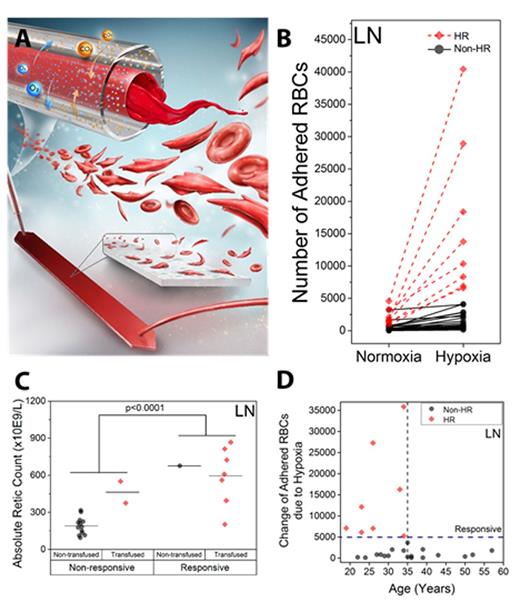Abstract
Abnormal cellular interactions and adhesion of blood cells to endothelium under hypoxic conditions are pathophysiologically central to Sickle Cell Disease (SCD). Analysis of the germane cellular interactions in physiologically relevant flow and oxygen tension conditions is technically challenging. We developed a low-cost, single-use micro-gas exchanger, integrated with a microfluidic device, with which to evaluate the effects of hypoxia. This system can simulate a range of physiological conditions, under which to analyze red blood cell (RBC) adhesion to endothelial or sub-endothelial components (here fibronectin, FN, or laminin, LN).
15 µL of surplus whole blood was injected on to FN- or LN-functionalized microchannels, after passing through a micro-gas exchanger composed of a gas permeable inner tubing inside a gas impermeable outer tubing (Fig. 1A). Blood flowed, and was deoxygenated, within the inner gas permeable tubing, while a controlled gas mixture (5% CO2 and 95% N2) flowed in the space between inner and outer tubing. Blood samples were flown into microchannels at physiological flow conditions (1 dyne/cm2), and at normoxic (98% SpO2) or hypoxic oxygen saturations (83% SpO2). Serial quantitative evaluation of RBC adhesion, using standardized protocols, were on >35 subjects (13 males and 22 females) with homozygous HbSS patients on whom we have correlative clinical data (institutional review board approved study).
Significant heterogeneity in the RBC adherence response to hypoxia was seen among SCD patients. RBCs from a hypoxia responsive (HR) population showed a significantly greater increase in adhesion compared to RBCs from a hypoxia non-responsive (non-HR) population, for both FN and LN (Fig. 1B, p=0.0001, one-way ANOVA). RBCs from the non-HR patient population had higher HbF values than did RBCs from the HR patient population (p=0.0079, one-way ANOVA). All HR RBCs had <7% HbF. Furthermore, patients with HR RBCs had significantly higher serum ferritin (p=0.0024, one-way ANOVA) and LDH levels (p=0.0128, one-way ANOVA), and higher reticulocyte counts (Fig. 1C, p<0.0001, one-way ANOVA) than did patients with non-HR RBCs. We also observed that 7 out of 8 subjects in HR subpopulation were transfused, whereas only 2 out of 15 subjects in the non-HR subpopulation were transfused (Fig. 1C). Moreover, the age distribution of HR patients was significantly younger (<35 years) than non-HR patients (Fig. 1D, p<0.05, Chi-Square). We suspect that the HR RBC phenotype associates with greater clinical disease activity, and more intensive therapeutic interventions, i.e., transfusions, overall.
Here, we reported adhesion of RBCs to endothelium associated proteins, FN and LN, under normoxic and hypoxic conditions, in a closed microscale environment under physiologically relevant flow conditions. The approach and technique presented here enabled us to control the oxygen tension of the blood in flow and to quantify the adhesion response of RBCs with SCD in a cost-efficient and patient-specific manner, demonstrating the effectiveness of our system. We identified a unique patient population whose RBCs, designated as 'hypoxia-responsive' (HR), showed enhanced adhesion, to LN and FN, in response to hypoxia in vitro. Clinical correlates suggest a more severe clinical in vivo SCD phenotype in this subgroup.
Acknowledgments: This work was supported by Grant # 2013126 from the Doris Duke Charitable Foundation and National Heart Lung and Blood Institute R01HL133574. Authors acknowledge Grace Gongaware for scientific illustrations, and contributions of patients and health care providers at University Hospitals.
Interrogation of RBC hypoxia responsiveness and clinical associations in SCD. (A) Blood deoxygenates at the micro-gas exchanger during flow. (B) Clustered patients in HR and non-HR populations, based on increase in RBC adhesion in response to hypoxia. HR patients showed significantly greater increase in the number of adhered RBCs with hypoxia compared to non-HR patients (p<0.05). (C) Patients with HR RBCs showed significantly greater reticulocyte counts compared to patients with non-HR RBCs. 7 out of 8 subjects in the HR patient subpopulation were transfused (>10% Hb A); 2 out of 15 subjects in the non-HR subpopulation were transfused. (D) Hypoxia responsive patients (N=8) were younger (<35 years). 8/16 subjects <35 years old and 0/10 subjects ≥35 years old were HR (p<0.05).
Interrogation of RBC hypoxia responsiveness and clinical associations in SCD. (A) Blood deoxygenates at the micro-gas exchanger during flow. (B) Clustered patients in HR and non-HR populations, based on increase in RBC adhesion in response to hypoxia. HR patients showed significantly greater increase in the number of adhered RBCs with hypoxia compared to non-HR patients (p<0.05). (C) Patients with HR RBCs showed significantly greater reticulocyte counts compared to patients with non-HR RBCs. 7 out of 8 subjects in the HR patient subpopulation were transfused (>10% Hb A); 2 out of 15 subjects in the non-HR subpopulation were transfused. (D) Hypoxia responsive patients (N=8) were younger (<35 years). 8/16 subjects <35 years old and 0/10 subjects ≥35 years old were HR (p<0.05).
No relevant conflicts of interest to declare.
Author notes
Asterisk with author names denotes non-ASH members.


This feature is available to Subscribers Only
Sign In or Create an Account Close Modal